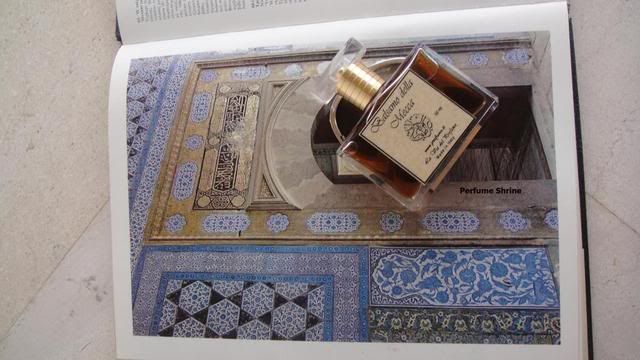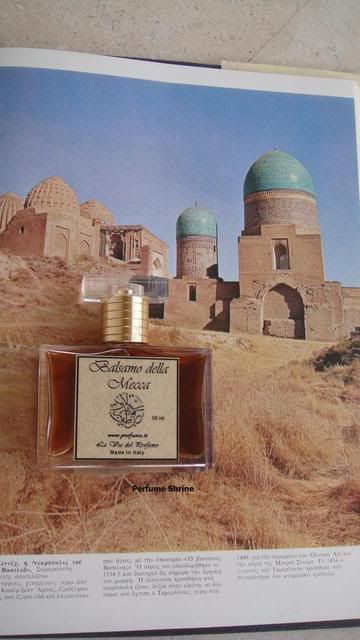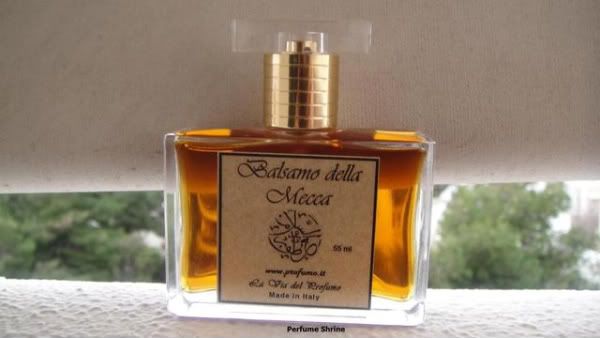O Marvel! a garden amidst the flames.~Ibn al-`Arabi, Tarjuman al-Ashwaq, in The Mystics of Islam, translated by Reynold A Nicholson
My heart has become capable of every form:
it is a pasture for gazelles and a convent for Christian monks,
and a temple for idols and the pilgrim's Kaa'ba,
and the tables of the Torah and the book of the Quran.
I follow the religion of Love: whatever way Love's camels take,
that is my religion and my faith.

Balsamo della Mecca, or Mecca Balsam in English, is the latest all-naturals fragrance developed by perfumer Dominique Dubrana, whose nom de guerre is Abdes Salaam. It was inspired by a trip the perfumer took to Mecca during Hajj. Salaam parallels the aromata invading the streets of Mecca with a river carrying labdanum, franincense,benzoin and agarwood, and which pours to the street 5 times a day along with the pilgrims who walk up to the great mosque. Accordingly Balsamo della Mecca/Mecca Balsam contains autocthone notes of: cistus labdanum, frankincense, benzoin, agarwood, tonka bean, tobacco, Indian tuberose and Damask rose.

The olfactory landscape of Arabia and Mecca in particular is unusual for a westerner, the proflugation of scents unforgettable, the catchartic ritual requiring the lavish use of perfumes up till taking the simple white dress of Ihram... This aromatic ambience was recreated through the artistry of one of the best all-naturals illusioninsts of this world, Dominique Dubrana of La Via del Profumo, an Italian niche line which includes the esoterically-named "Scents of the Soul". Regular readers will recall how the vetiver-infused Samurai as well as the euphorically tangy neroli marvel Morning Blossom have occupied these pages in the past. This time Salaam was most generous in offering one full-size bottle of the latest fragrance to one of our readers, which I took some liberties in photographing for your enjoyement (So if you want to win, you know what to do, leave a comment!)

Comparing Mecca Balsam to other scents, one would be inclined to classify it alongside the rich ambience of Amouage oriental attars (Amouage attar Tribute isn't at all foreign to this idea) with their majestic sweep and incredible lasting power. Even though most all-naturals have a more fleeting appearence, some of these base-heavy Arabian inspired compositions, such as Mecca Balsam, anchor themselves with conviction through the marriage of resinous and balsamic touches.
Indeed Mecca Balsam feels like it is all base, all depth, all the time! Its wonderful, smoky-ambery leather core is comprised mainly of labdanum and incense (both benzoin and frankincense for the latter; interpolating warm and cool, sweet and sour respectively) and these two notes reverberate throughout the duration of the fragrance on the skin almost audibly, such is their bass & drum dynamics! Lovers of the shredded tobacco and "cola" effect (due to the synergy of tonka bean and the balsams) that hides in the heart of classic orientals such as Youth Dew, Tabu and the percursor Coty's L'Origan, or more modern interpretations such as YSL's Opium, Escada Collection and even Eau d'Italie's Paestum Rose (with its root beer vibe), will be delighted to find a replicable effect in Mecca Balsam. These would also provide great layering partners in lotion form, to traject the tracks into the night. Aficionados of the mini-cult that is Madame X by Ava Luxe will find in Mecca Balsam a luxurious upgrade using only the finest ingredients.
Even though agarwood (oud) is mentioned within the notes, its inclusion is not the -be-all-end-all of the presentation like it is with several Montale oud fragrances or indeed some of the other "ouds", such as By Kilian or Tom Ford's. Instead working its magic in the wings, it only hints at its presence, as do the precious flowers (rose and tuberose). Mecca Balsam could be worn by both sexes with ease and is sure to create both a warming, reassuring ambience around you as well as a pulling, sexy effect that won't go unnoticed.

Balsamo della Mecca/Mecca Balsam is available directly from La Via del Profumo in 16ml bottles (for €34,17) or 55ml (for €91,67) of Eau de Parfum.
This is the actual bottle that will be given to one lucky reader, courtesy of Profumo.it.
Related reading on Perfume Shrine: Labdanum, an important material, Abdes Salaam/Profumo.it scents, Scents with leather notes, Labdanum scents and info
All photographs © by Elena Vosnaki/Perfume Shrine.
.jpg)


.bmp)






